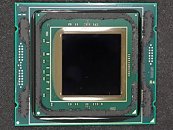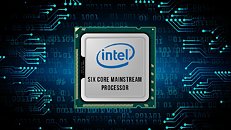Friday, September 22nd 2017

Intel Core i7 8700K Reportedly Reaches 4.8 GHz Easily, 5 GHz+ Requires Delid
A report out of Expreview says that users should expect Intel's 8700K 6-core processor to easily clock up to 4.8 GHz with conventional cooling methods. Apparently, the chip doesn't even need that much voltage to achieve this feat either; however, thermal constraints are quickly hit when pushing Intel's latest (upcoming) leader for the mainstream desktop parts. Expreview says that due to the much increased temperatures, users who want to eke out the most performance from their CPU purchase will likely have to try and resort to delidding of their 8700K. While that likely wouldn't have been necessary with Intel's 7700K processors, remember that here we have two extra CPU cores drawing power and producing waste heat, so it makes sense that thermals will be a bigger problem.
This is understandable: Intel is still using their much chagrined (and divisive) TIM as a heat conductor between the CPU die and the CPU's IHS (Integrated Heat Spreader), which has been proven to be a less than adequate way of conducting said heat. However, we all knew this would be the case; remember that Intel's HEDT HCC processors also feature this TIM, and in that case, we're talking of up to 18-core processors that can cost up to $1,999 - if Intel couldn't be bothered to spend the extra cents for actual solder as an interface material there, they certainly wouldn't do so here. As with almost all peeks at as of yet unreleased products, take this report (particularly when it comes to frequencies, as each CPU overclocks differently) with a grain of salt, please.
Source:
Expreview
This is understandable: Intel is still using their much chagrined (and divisive) TIM as a heat conductor between the CPU die and the CPU's IHS (Integrated Heat Spreader), which has been proven to be a less than adequate way of conducting said heat. However, we all knew this would be the case; remember that Intel's HEDT HCC processors also feature this TIM, and in that case, we're talking of up to 18-core processors that can cost up to $1,999 - if Intel couldn't be bothered to spend the extra cents for actual solder as an interface material there, they certainly wouldn't do so here. As with almost all peeks at as of yet unreleased products, take this report (particularly when it comes to frequencies, as each CPU overclocks differently) with a grain of salt, please.


119 Comments on Intel Core i7 8700K Reportedly Reaches 4.8 GHz Easily, 5 GHz+ Requires Delid
In terms of heat, you guys gotta remember that larger area means greater spread.
Too many variables to control.
It's simply cost cutting, b/c they're not achieving their desired profit margin, ESPECIALLY with AMD on their ass. They know the fanbots will buy them no matter what, so they're going to abuse their stupidity.
AMD soldering them is irrefutable proof that it's A-OK to do. Companies will cut out a tiny resistor/capacitor or two on a PCB that aren't even a penny. Intel is definitely going to save this cash.
So let's say solder isn't safe for long term scenarios, when you buy a premium CPU and you pay a premium price for it they are OBLIGATED to use a really good quality tim instead of the trash they are using and this trash gets dry VERY fast.
Premium my @ss if you ask me.As a customer i don't care if this will cost them more or if they have to work more for it, cause i paid for all that.
7700k runs way too hot for my taste,yes its a decent CPU but 80C with a decent air cooler while gaming is unacceptable even during summer.
Why do i have to delid this trash and make it operate in a more decent temp range?
If TIM is the future then make it better or go back to solder or stop asking for premium prices.
peace :)
They arent obligated to do squat. You are paying for the unlocked multiplier and notably the fastest base and boost clocks.
It really doesnt dry out fast either. I know there are cases, but if it was a real problem wed see it a lot more.
I think we all agree wed like to see solder, but to call it an obligation and trash is pretty misplaced and dramatic.
For clocking enthusiasts that freeze their CPUs for benchmarking, solder can most definitely be an issue. For everyone else, paste is fine; solder performs better in most instances, but isn't really going to make or break an OC. Those few hundred MHz don't have much in tangible benefits, just like your worry about 80c+ temperatures. Like I know, 100C is crazy, because water boils at that temp, but your CPU will not. It's a mind-over-matter subject.
For me personally, the day Intel goes solder on mainstream CPUs, they've got issues. Their ONLY reason to use solder, as a chip maker, is to either appease the less than 10% of your user base that might be enthusiasts, of which only some care about this "problem"....
or they are like AMD, and need that solder, and your CPUs have no overhead.
Like, Intel can keep using paste forever if AMD doesn't actually provide them with real competition. Because right now, AMD still doesn't shine in the light that is Intel's per-core performance.
I also said you paid for a 600mhz bump in clockspeeds along with that unlocked multiplier. The paste really has nothing to do with it the price premium. Ive seen plenty of these on stock paste in 4.8-5ghz range. Sure, it needs a 2x120/140mm aio, but, its there. Putting solder on it MIGHT get you another 100-200mhz... not more in most cases.
Better than amd who, with solder, cant even get past their own boost clocks, yet people who arent using the cores, its one main advantage, are still buying them.
It'll be interesting to see how these unreleased CPUs do when they get released compared to the X299 chips, for sure.
...It would be interesting to look back and see if the times Intel did solder were when AMD's chip had been ahead. (Thats why I figured AMD's new 16core Cow-Tipper is soldered)Everyone maximizes profit. At the end of the day thats what you do.
...You have to because you never know whats coming. Margins can be tiny, 5% profit is standard in most mfg. (though idk about intel, but on average), so 1 bad year of half the revenue takes 10 normal years of profit to ameliorate...Hence why everyone is always after profit..
Even the tiniest gain in yields is reason enough for Intel. (The CPU soldering process is a complex one of relatively exotic, layered, & hard to manage materials)
1 there's a few dealing with high heat levels and complaining on here sooo , also they limit your performance via such things.
2 liquid metal ,nahhh because shorts and it stays liquid and can flow out of position.
3 if a cpu is soldered it will need no maintenance , there's not much to fix and no one does , they last beyond their usefulness.
Hope that helps.